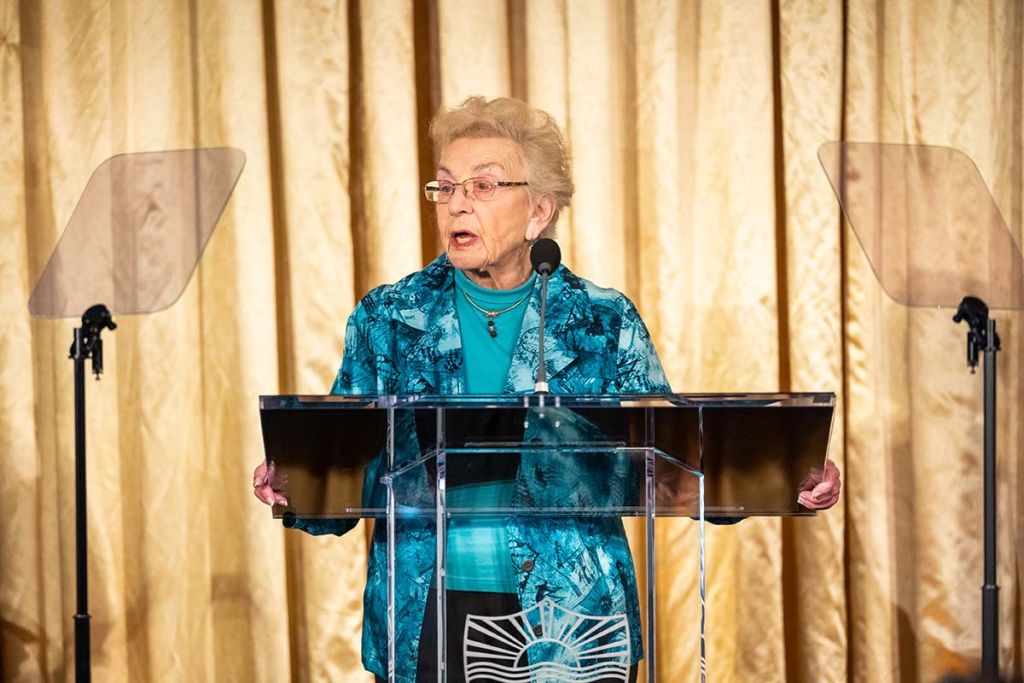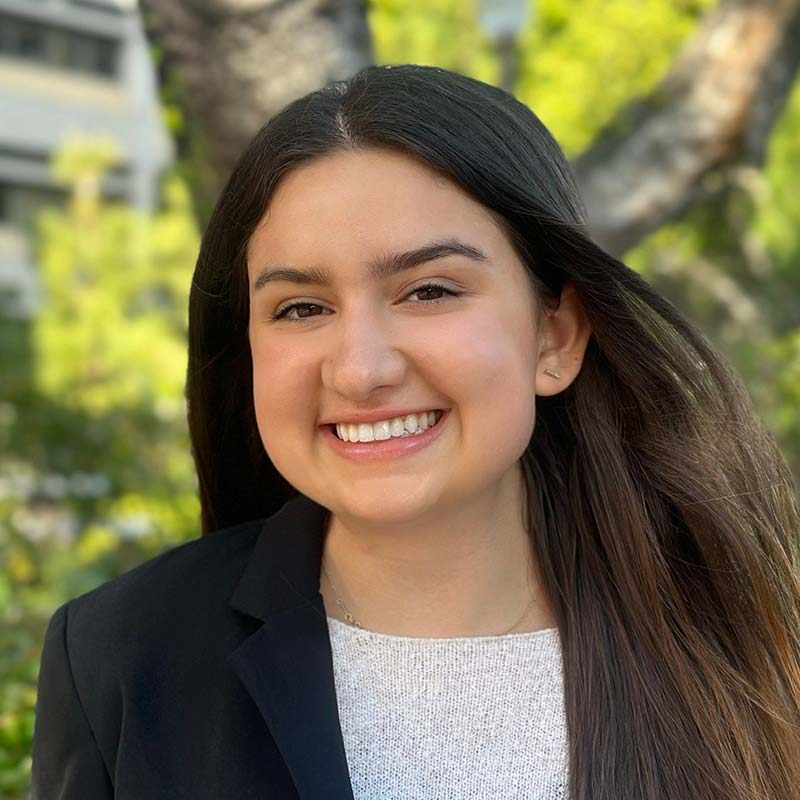Schindler’s List Survivor Celina Biniaz Warns Against the Corrosive Power of Hatred

For years, Celina Biniaz, one of the youngest people saved by Oskar Schindler, did not tell anyone – not even her children – that she was a Holocaust survivor. She feared no one could comprehend what she had been through, and she didn’t want to impose the trauma of her childhood upon her son and daughter.
Celina’s reluctance to speak ended in 1994. That year, director Steven Spielberg brought Oskar Schindler’s story to the screen with Schindler’s List. He established Survivors of the Shoah Visual History Foundation, which later became the USC Shoah Foundation.
In 1996, Celina recorded testimony for the USC Shoah Foundation’s Visual History Archive.
“Oskar Schindler saved my life by adding my name and the names of my parents to his list of workers who were to be protected from Nazi deportation. And 50 years after the war, you, Steven, restored my life by giving me back my voice,” Celina said to Steven Spielberg during her remarks at USC’s historic University Medallion program on March 25.
Celina was a featured speaker at the event in which Dr. Carol Folt, President of the University of Southern California, awarded a University Medallion to the 52,000 Holocaust survivors who recorded testimony with the USC Shoah Foundation, which celebrates its 30th anniversary this year. Only three prior University Medallions have been given in the history of USC.
At the event, Celina spoke of Mater Leontina, a German nun who taught her English and German after the war.
“I spent two years studying with her. Her patience and kindness restored my self-respect and helped me conquer my feelings of anger and bitterness,” Celina said at the event. Then, she addressed Steven Spielberg: “Thanks to you, I can tell the world about how the Nazis stole my childhood. And I can also tell all of you about the kindness of a German nun.”
Now in her 90s, Celina has been sharing her story with students and other audiences for 30 years.
“One can read about the Holocaust in history books, but there is no match from listening to a person tell his or her personal story,” she said at a 2016 event. “I find that the human voice is probably the most important vehicle to get attention. So many people have watched my testimony and contacted me to say that it touched their lives. In some cases, people have said that it even inspired them to change their lives.”
Saved by Schindler: The Life of Celina Karp Biniaz, by William B. Friedricks was published in 2022. Last year, Celina shared her story with a private audience in the living room of Wonder Woman star Gal Gadot.
Born in Kraków in 1931, Celina was eight years old when Nazi troops entered her hometown during the German invasion of Poland. Before the war, she had enjoyed a comfortable middle-class childhood, attending school and watching the film "Snow White." Her parents, Irvin and Phyllis Karp, both worked as accountants.
When the Nazis occupied the city, Celina's school closed. Celina’s parents, fearing for their livelihood and lives, began selling their valuables.
By March 1941, German authorities forced the Karps and an estimated 16,000 other Jews into the Krakow Ghetto.
The Karps were luckier than most. The clothing factory where Irvin had once consulted as an accountant was taken over by Austrian businessman Julius Madritsch, and he hired Irvin to run the factory. Madritsch later brought Phyllis on board to keep the books, which afforded the Karps extra resources and protection from deportation.
Irvin and Phyllis procured false papers for Celina that showed her age as 12 years old instead of 10, which enabled her to leave the ghetto to work under Madritsch’s protection. In her testimony, Celina describes Madritsch as an “exceptionally decent human being.”
In 1943, the Nazis shut down the Krakow Ghetto, killing thousands of Jews and sending even more to certain death in the concentration camps. The Karps were transported to the nearby Płaszów Concentration Camp and were forced to live in barracks, but they were able to continue to work in the relative safety of Madritsch’s factory.
In 1944, when Madritsch was ready to close his factory, Oskar Schindler forever changed Celina's life.
For years, Oskar Schindler had been protecting Jewish workers at his enamelware factory in Krakow. In 1944, he was planning to relocate the factory near Brünnlitz, his hometown in the Protectorate of Bohemia and Moravia, and he had drawn up lists of 1,200 Jewish workers to take with him.
Schindler tried to encourage Madritsch to do the same.
Celina recalled in her testimony, “Madritsch said he didn't want to, that he'd had enough of the whole thing. But then Schindler said, 'I am making a list of people that I'm taking with me, and because we are friends, I want you to give me some names of your people.' And that's how we got on Schindler's list. And that's how we survived."
Irvin was sent to work in the safety of Schindler's new factory. But Celina and Phyllis and some 300 other women were mistakenly sent to Auschwitz.
Describing the camp conditions, Celina recalled, "We ended up in Auschwitz in the middle of the night. That was a horrible experience…The smell of burning flesh, shouting orders, not knowing which way to go."
Soon after arrival, Celina, then 13, and her mother were forced to strip naked.
"They shoved us in the shower room, and we didn't know what to expect, whether we were going to have the gas or whether they were going to have actual water. It was a horrible experience. When the water finally came, it was just like we couldn't believe it," she said.
After five weeks, Oskar Schindler arrived at Auschwitz to secure the release of the women on his list. Celina, her mother, and the other women were transported to Brünnlitz, where Celina lived and worked at Schindler's factory until the end of the war.
To this day, Celina still has one of the five pairs of scissors from working in the factory.
Oskar Schindler and Julius Madritsch were later recognized by Yad Vashem as "Righteous Among the Nations" in honor of how they risked their lives to save Jews during the Holocaust.
Celina and her parents immigrated to the U.S. in 1947, settling in Iowa, where Biniaz graduated from Grinnell College and earned a graduate degree in special education in New York. She and her husband, Amir Biniaz, had two children, Rob and Susan. They retired and moved to California in 1993.
In 2015, Celina returned to Auschwitz through the USC Shoah Foundation to mark the 75th anniversary of the liberation of the infamous death camp.
Celina continues to travel, speaking at museums and in classrooms.
“We must never give in to the corrosive power of hatred,” Celina said at the University Medallion event. “And we must always remember the power each individual has to transform the lives of others.”
Watch Celina’s full testimony.
Like this article? Get our e-newsletter.
Be the first to learn about new articles and personal stories like the one you've just read.
